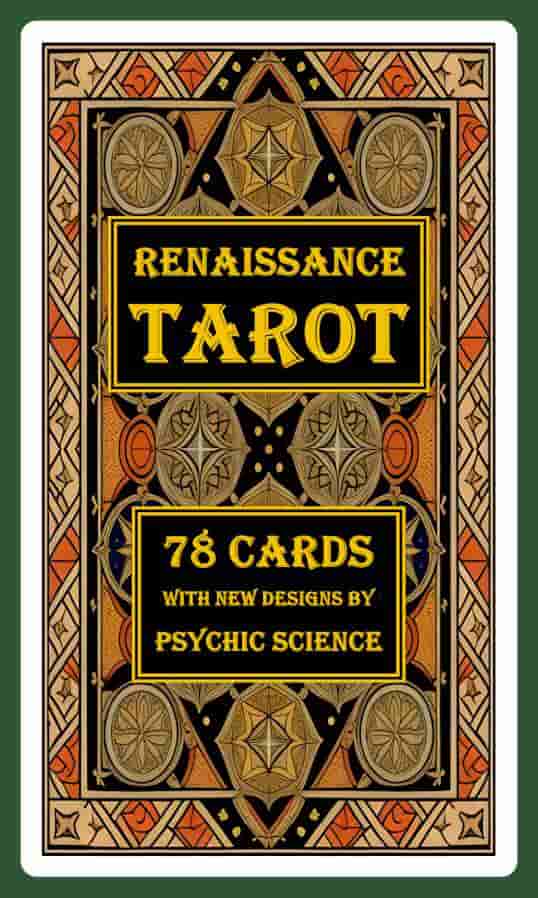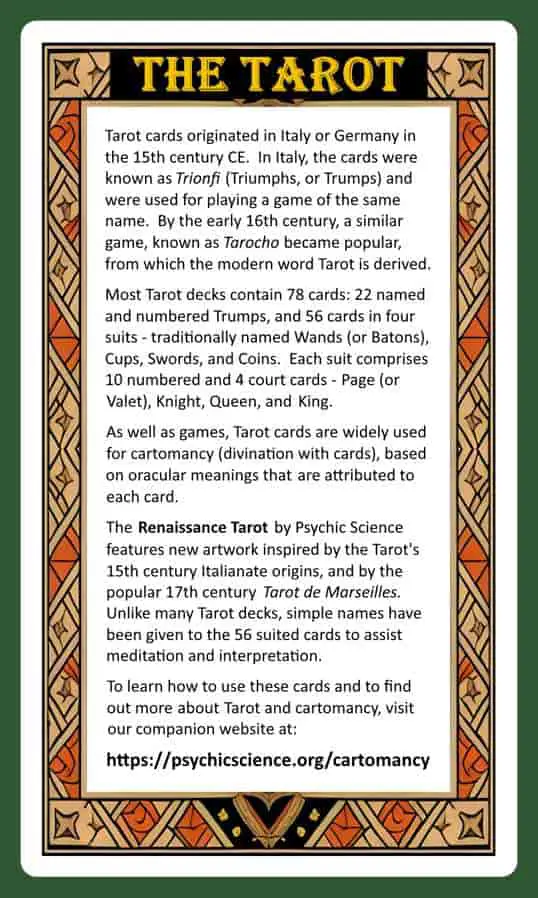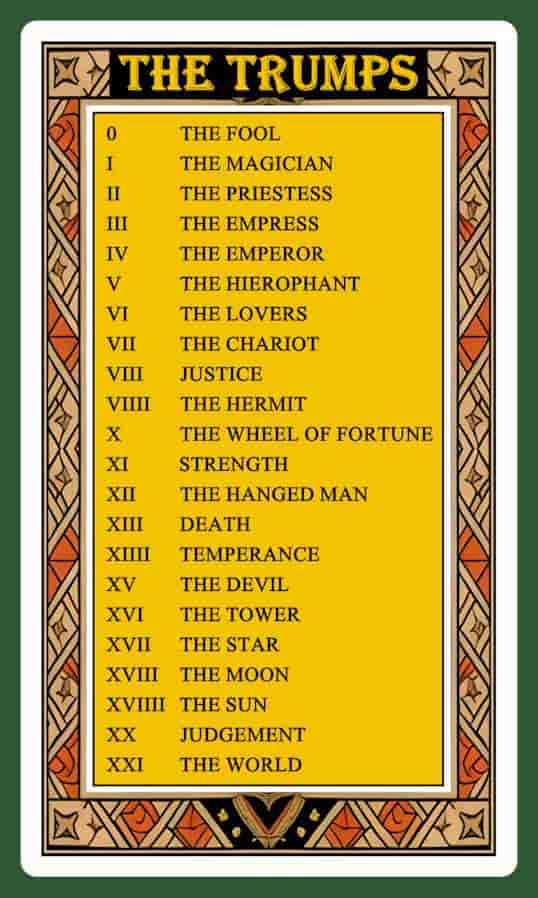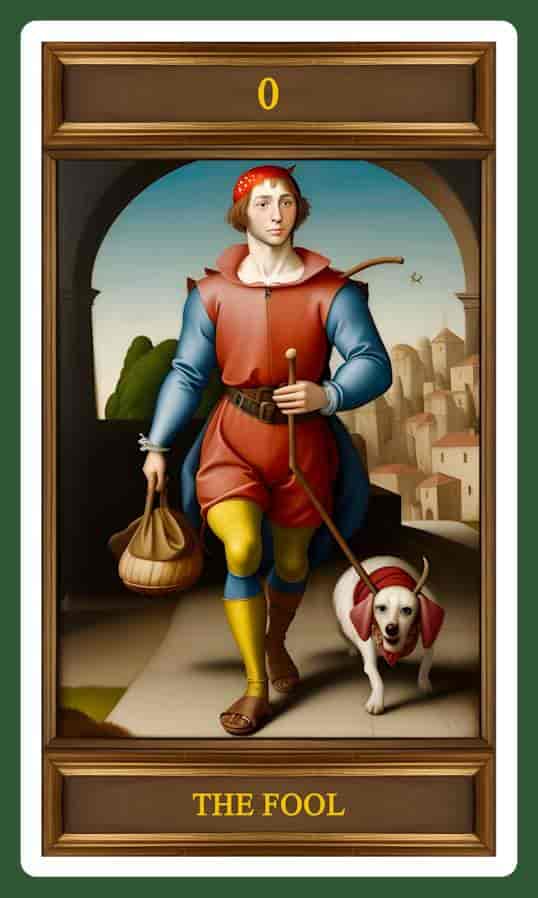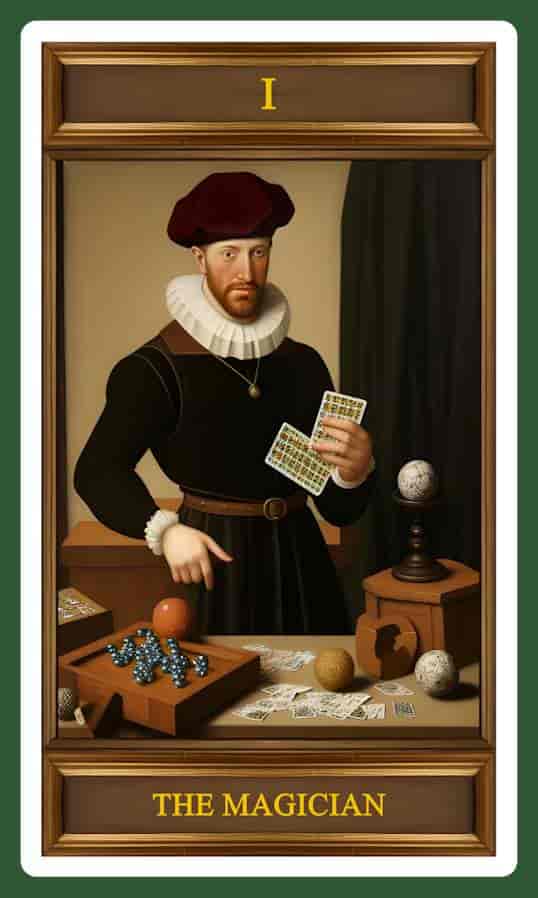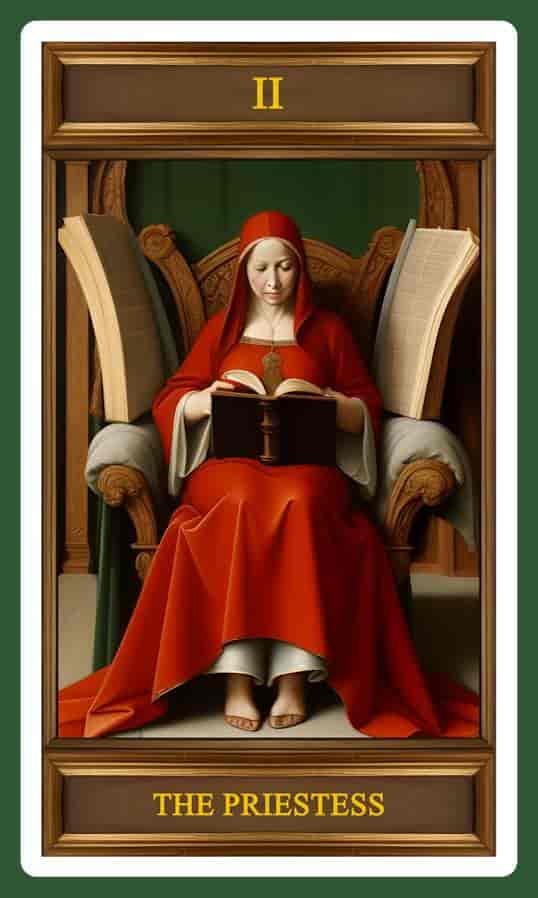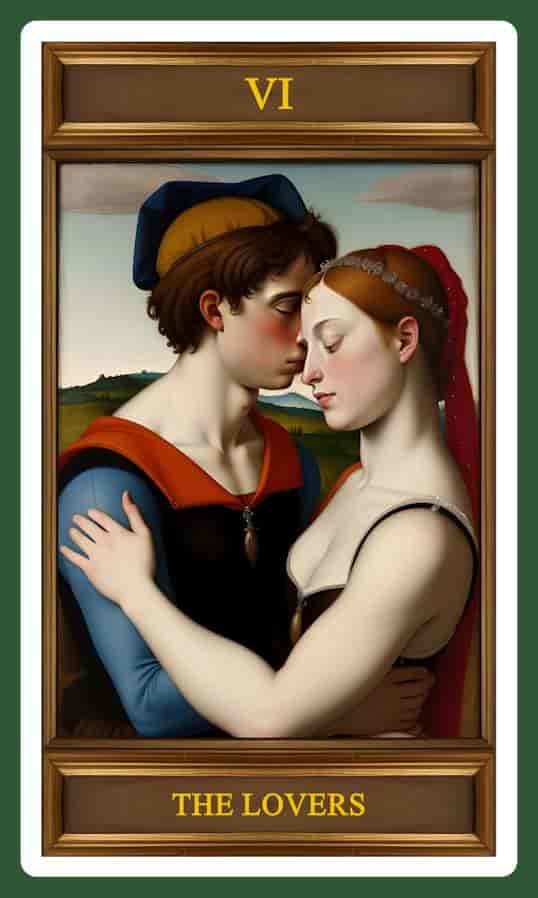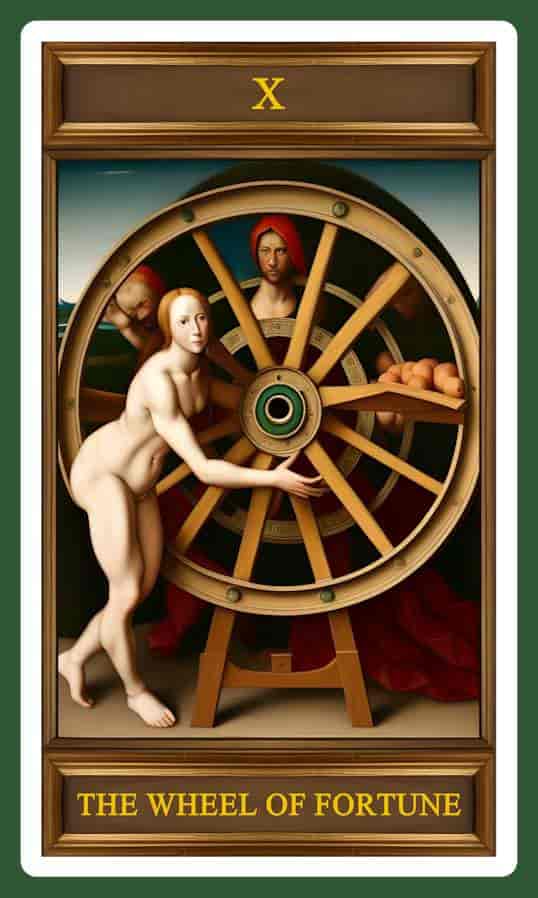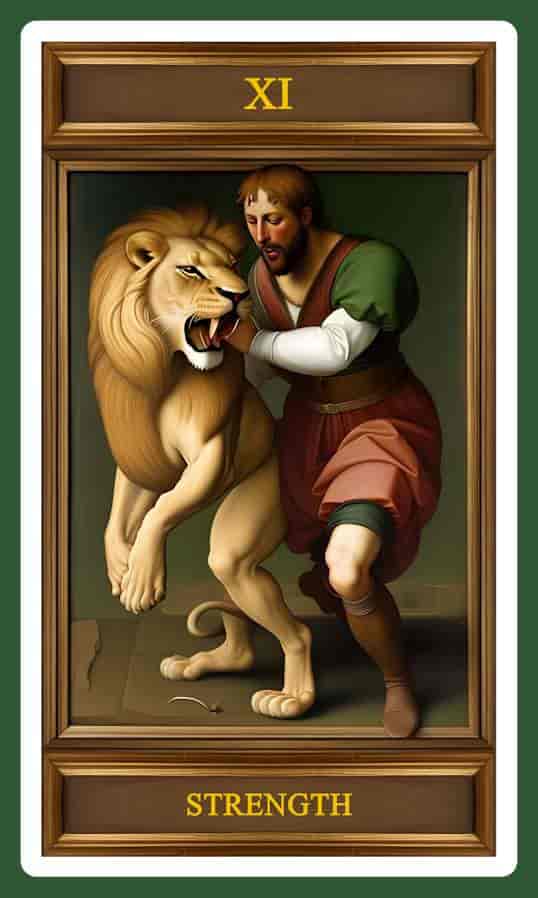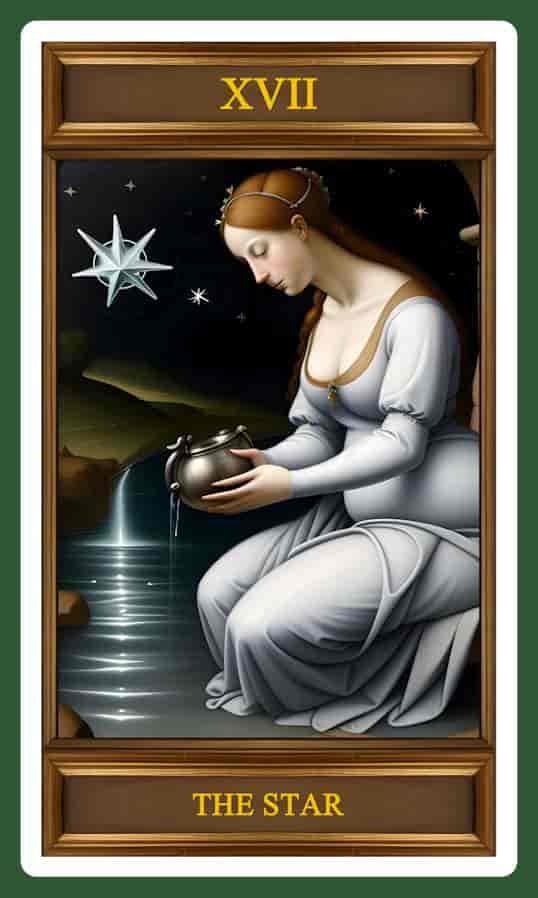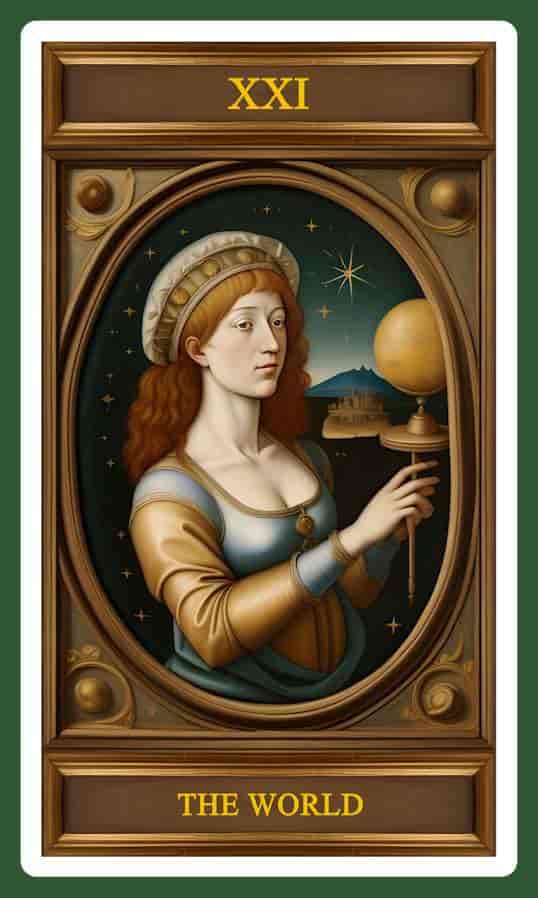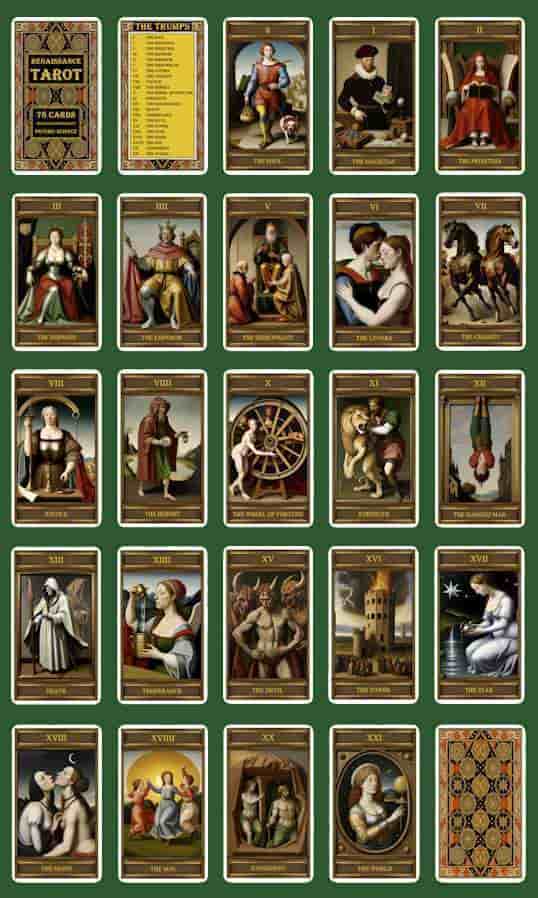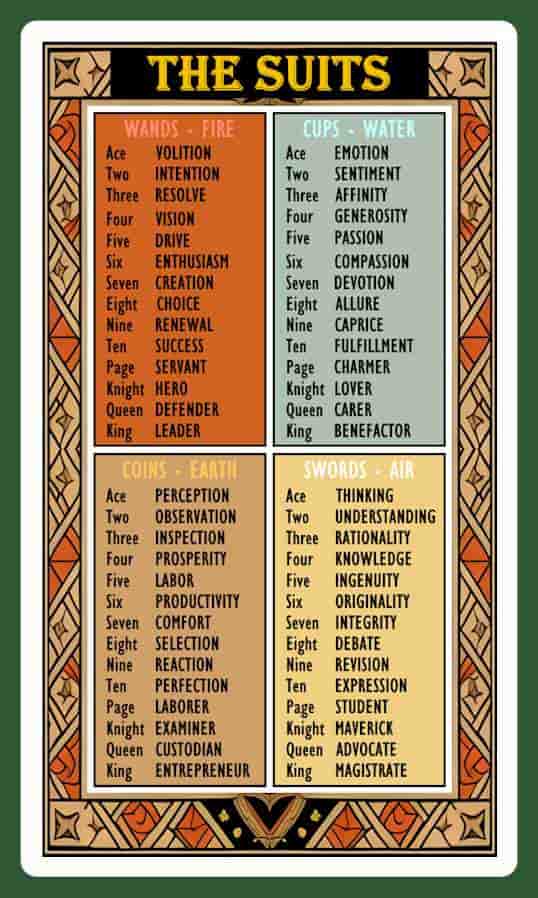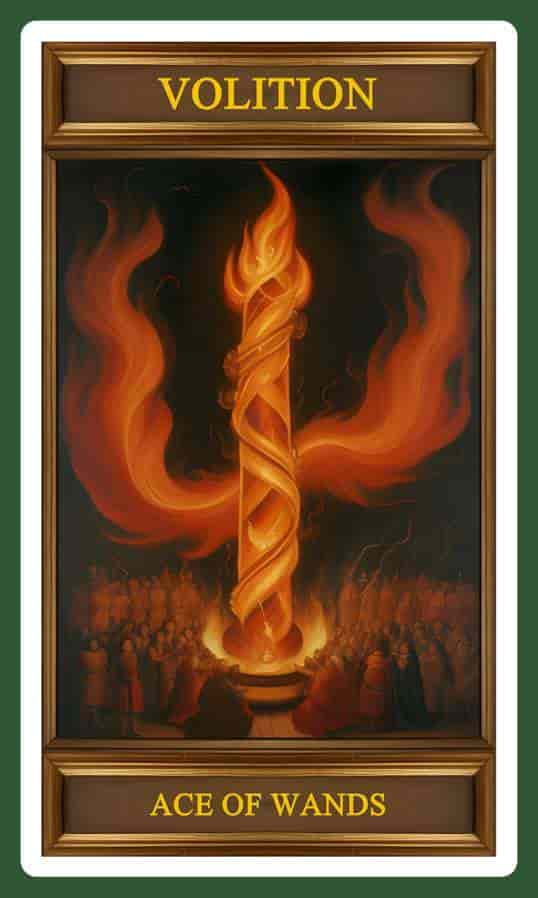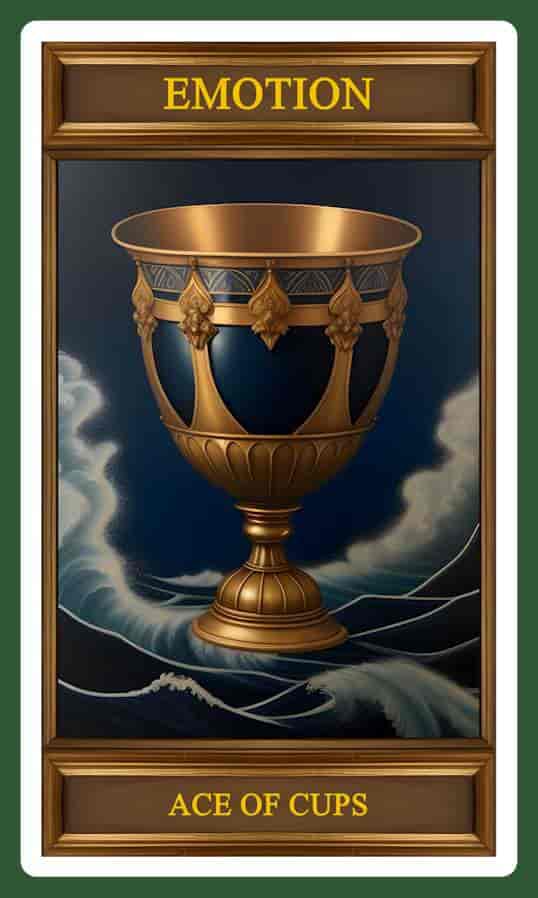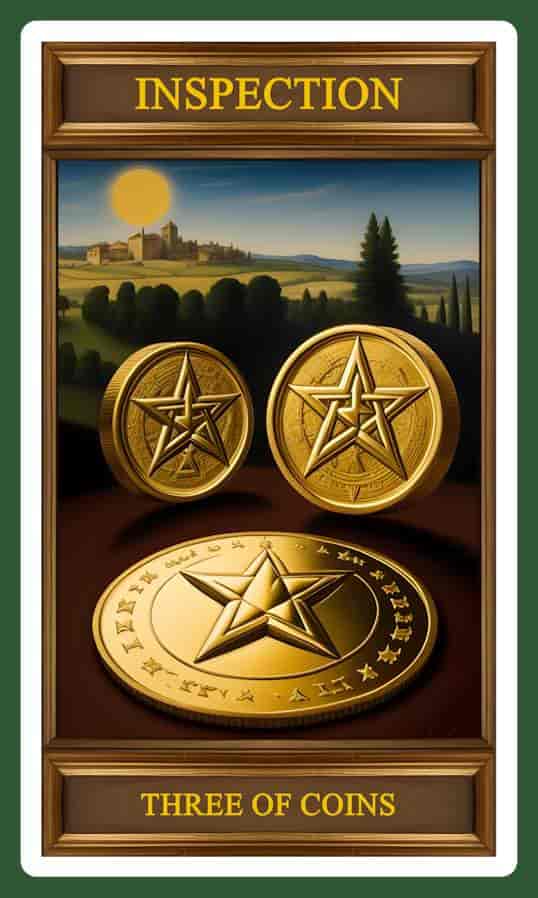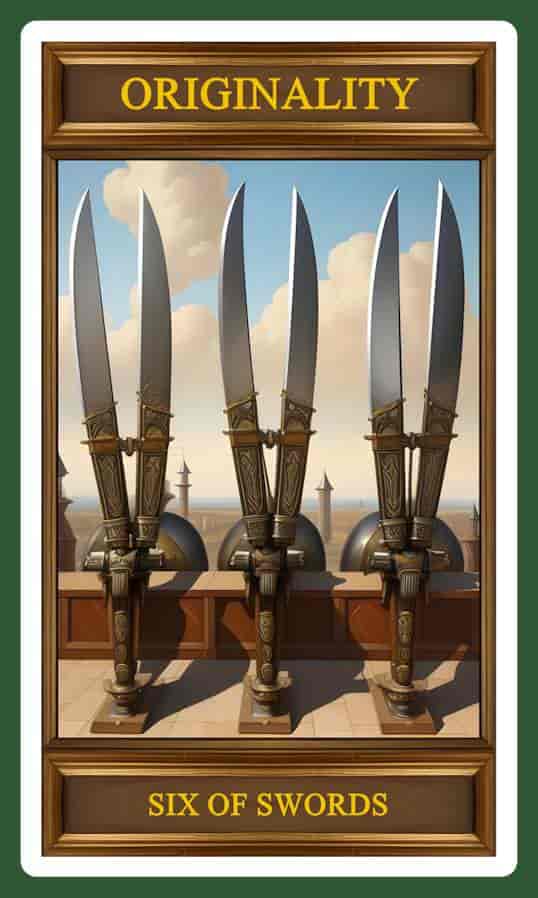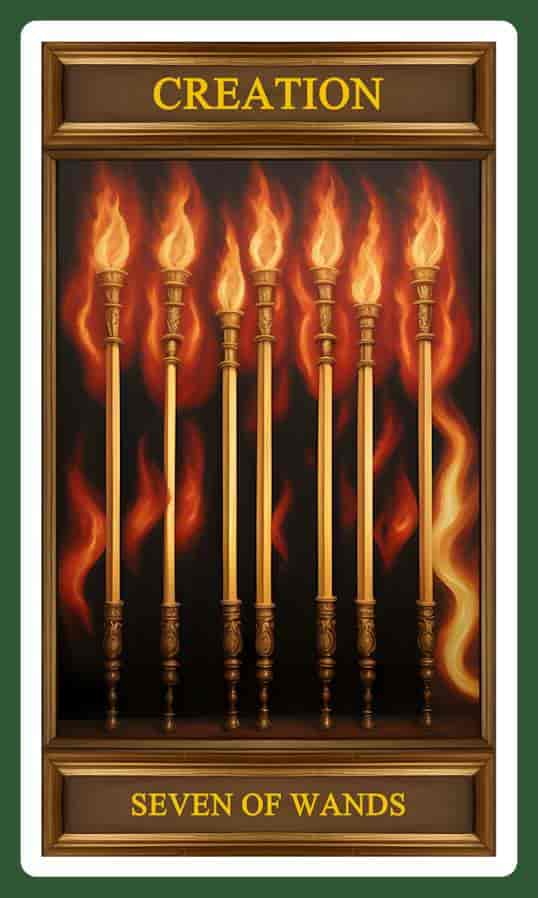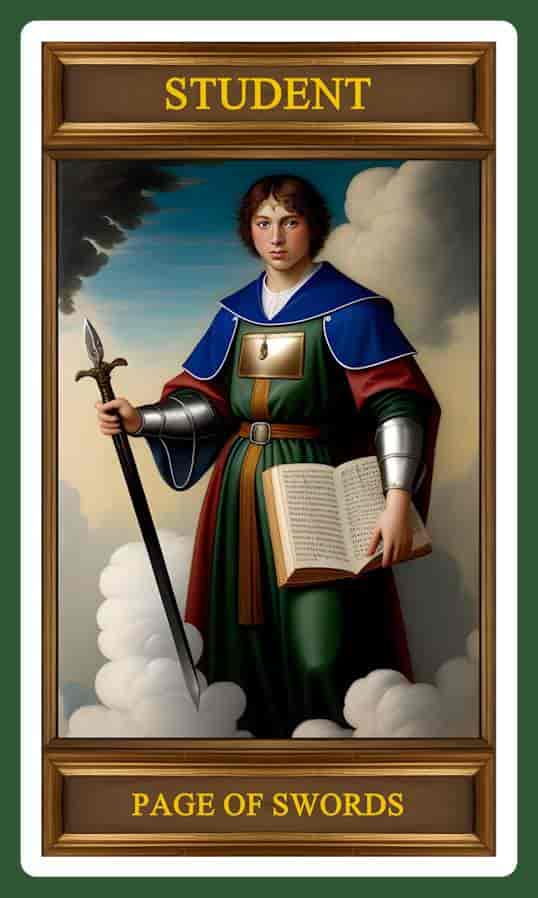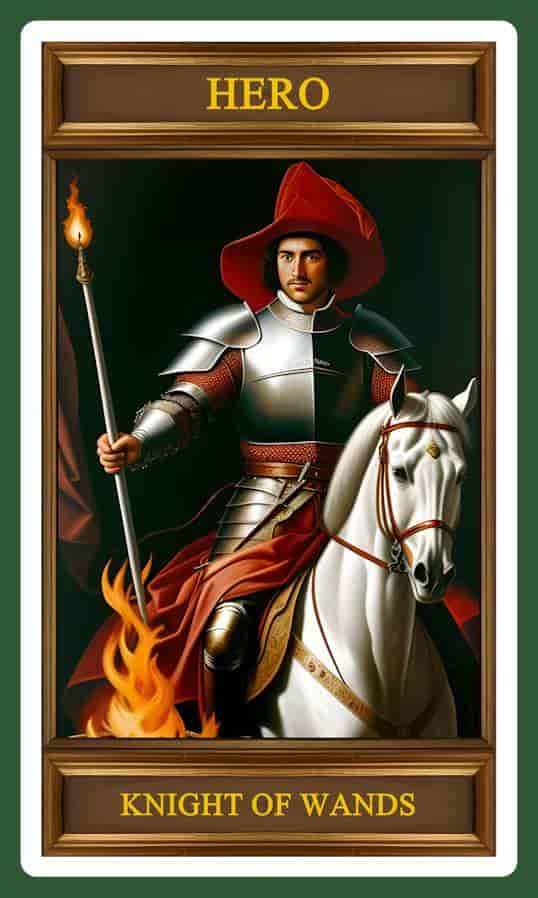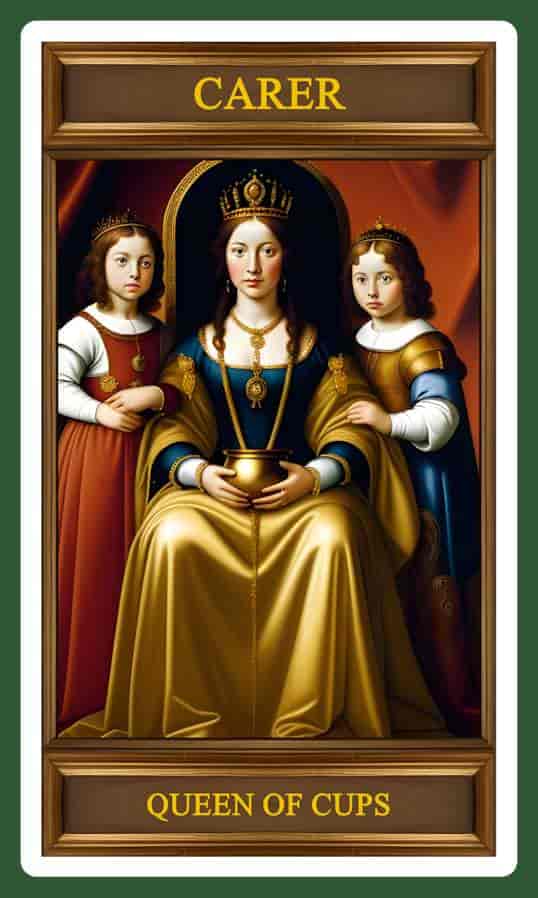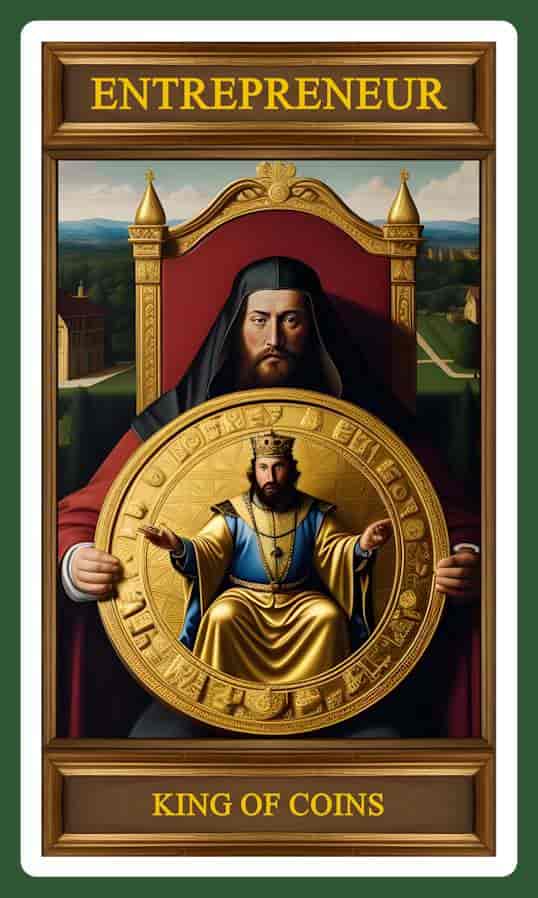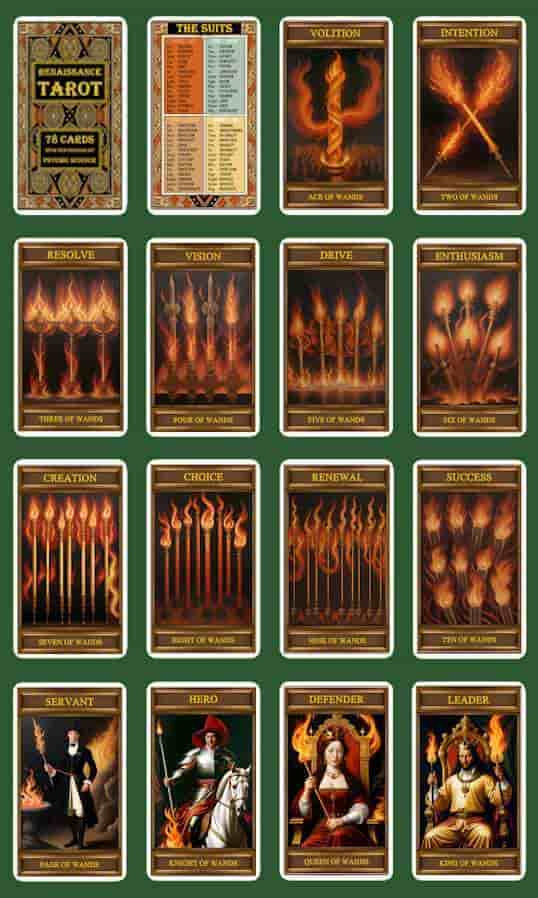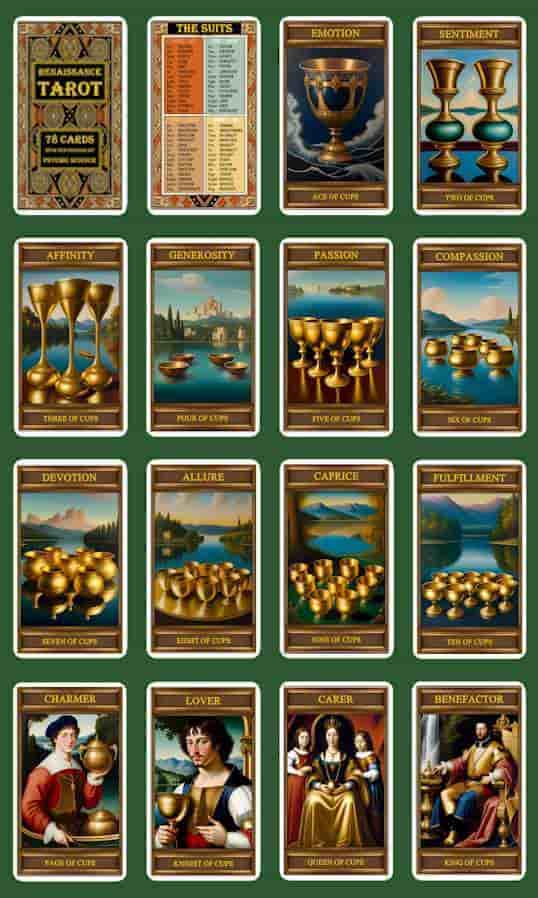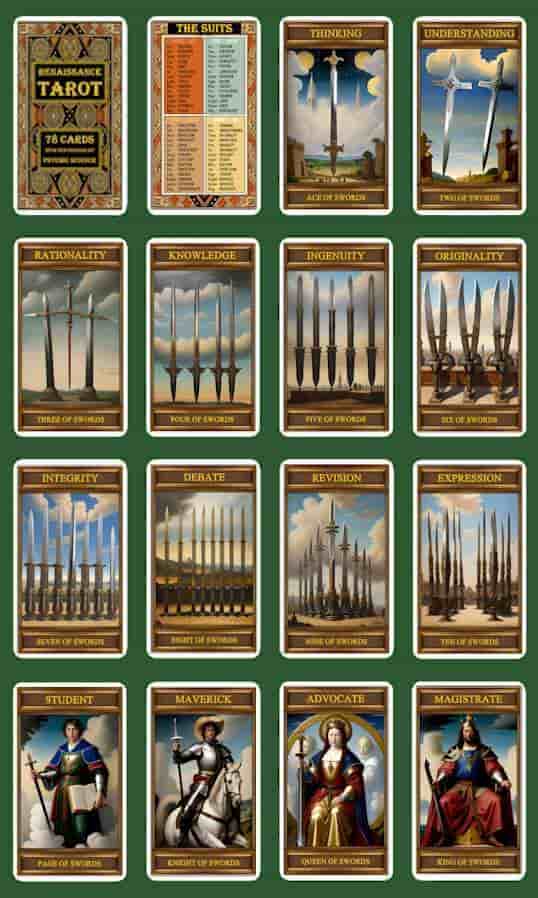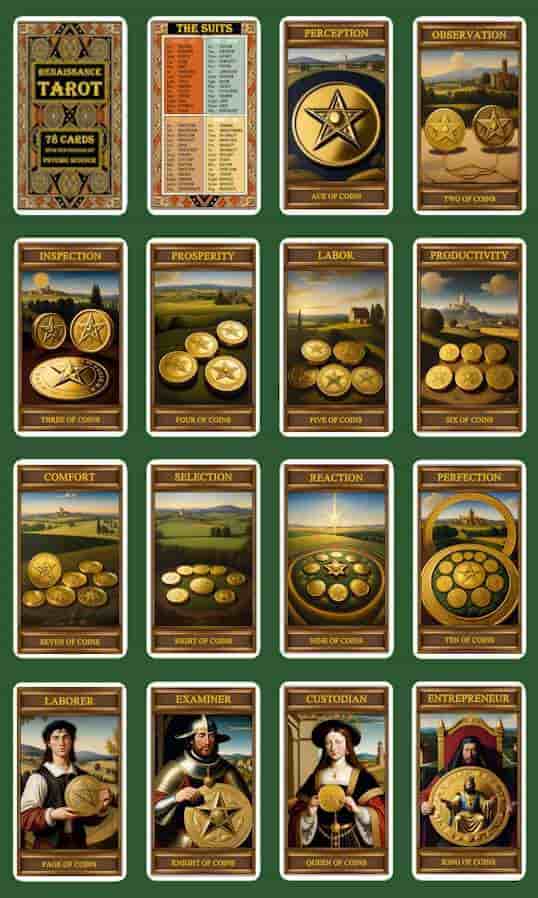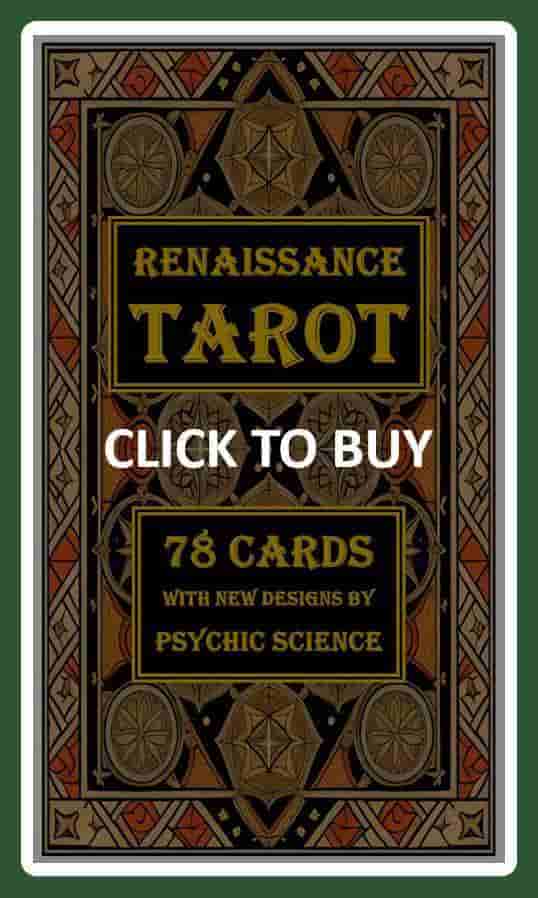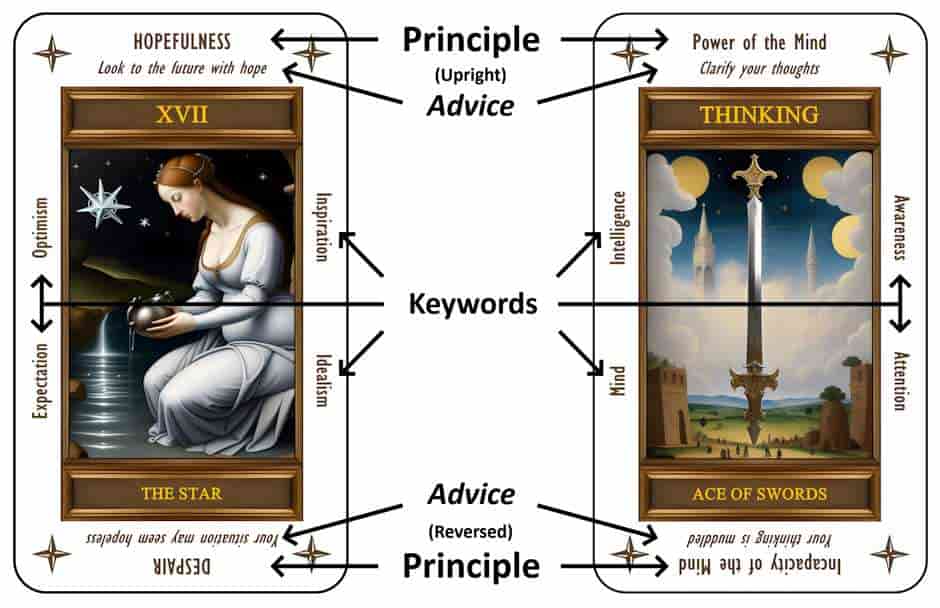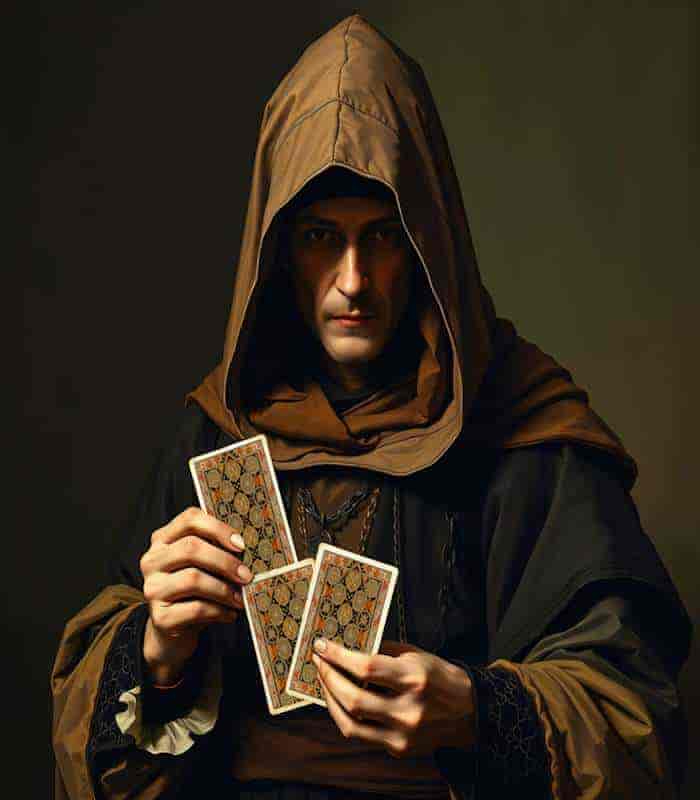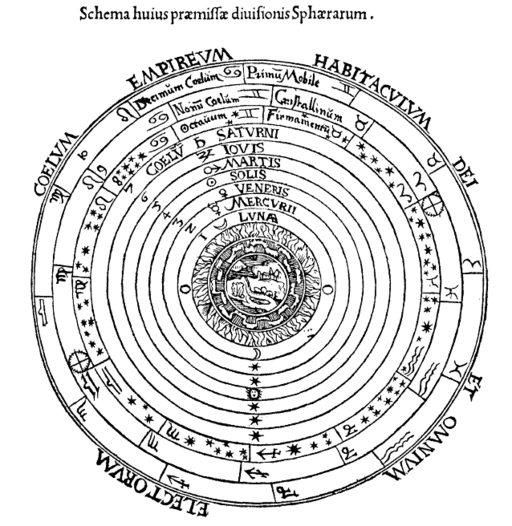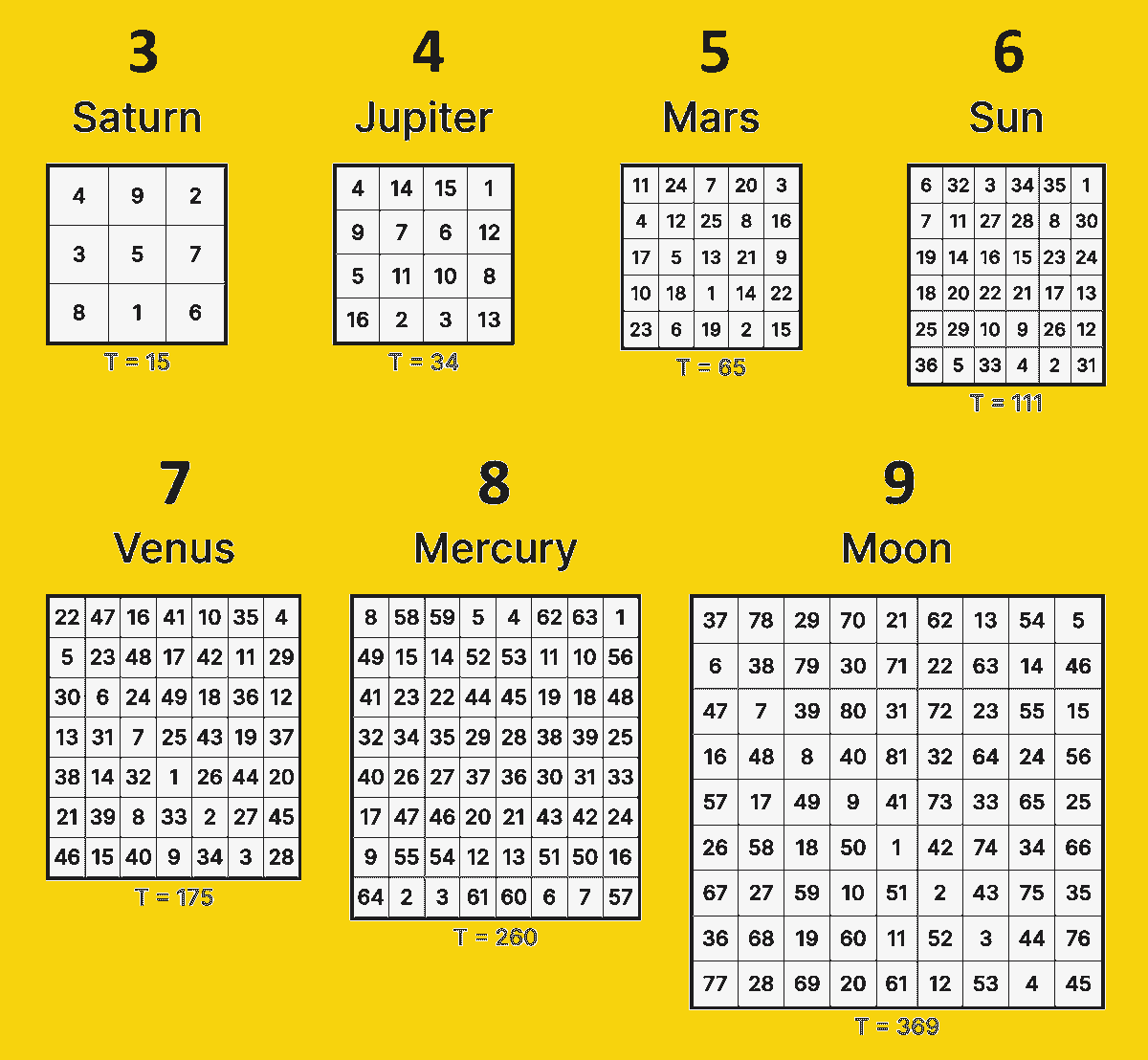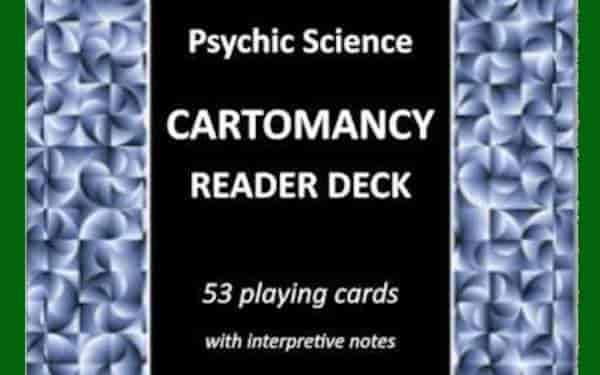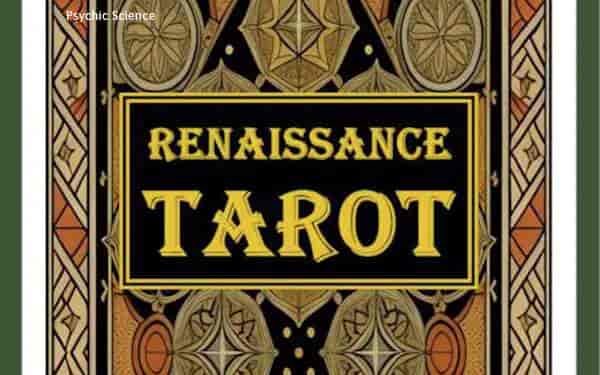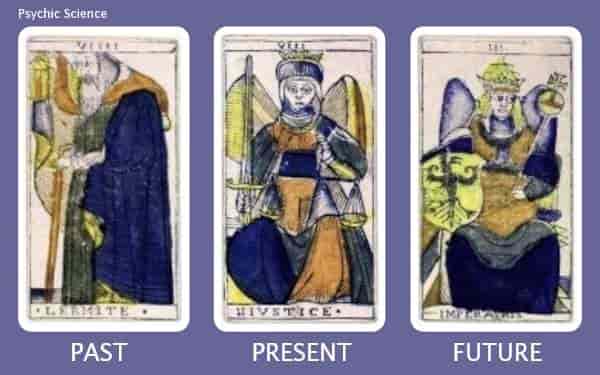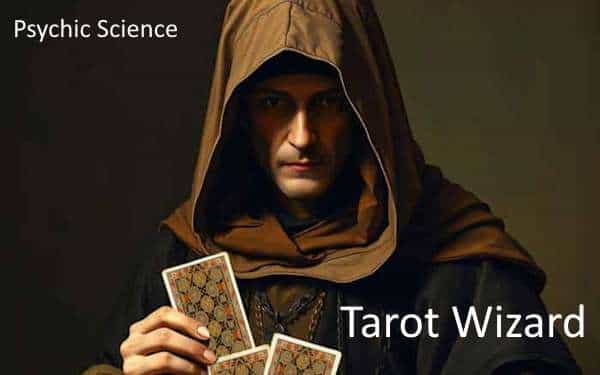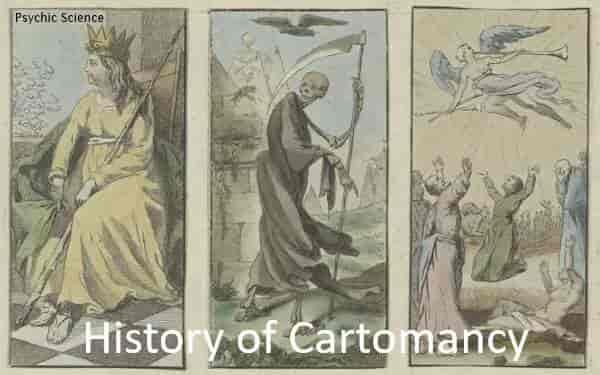
The Renaissance Tarot
Discover our exclusive tarot deck

Psychic Science Renaissance Tarot
These new designs reflect the 15th century Italian Renaissance origins of the tarot and incorporate the themes and structure of the influential 17th century Tarot de Marseilles.
Psychic Science presents
RENAISSANCE TAROT
Standard tarot size, superior card stock
Presented in an elegant purple velvet bag
Scroll through for preview
slide 1 of 27

The Annotated Renaissance Tarot
As an aid to interpretation, the Renaissance Tarot is now available in an annotated edition. Each card in this edition includes four keywords, together with its principle and suggested advice for both upright and reversed orientations.
Like the original edition, the full 78-card deck is standard tarot size, printed on superior card stock, and presented in an elegant purple velvet bag.
Tarot Wizard Online Oracle
We are now proud to present The Renaissance Tarot as a free online interactive oracle.

The Trumps
The 22 Renaissance Tarot Trumps are numbered according to the Tarot de Marseilles traditional sequence, but use the modern esoteric names for certain cards (e.g., the traditional 'Pope' is renamed 'Hierophant').
The following table is a guide to the interpretation of each trump, including typical indications when the card is upright and reversed.
INTERPRETING THE TRUMPS
| # | TITLE | UPRIGHT | REVERSED |
| 0 | THE FOOL | INNOCENCE | NAIVETY |
| I | THE MAGICIAN | ARTFULNESS | INEPTNESS |
| II | THE PRIESTESS | WISDOM | IGNORANCE |
| III | THE EMPRESS | SECURITY | INSECURITY |
| IIII | THE EMPEROR | COMMAND | TYRANNY |
| V | THE HIEROPHANT | FAITH | DISBELIEF |
| VI | THE LOVERS | LOYALTY | INFIDELITY |
| VII | THE CHARIOT | FORCEFULNESS | AGGRESSION |
| VIII | JUSTICE | BALANCE | IMBALANCE |
| VIIII | THE HERMIT | HUMILITY | SECRETIVENESS |
| X | THE WHEEL OF FORTUNE | FORTUITY | MISFORTUNE |
| XI | STRENGTH | ENDURANCE | IMPOTENCE |
| XII | THE HANGED MAN | ATONEMENT | PUNISHMENT |
| XIII | DEATH | TRANSFORMATION | DEGENERATION |
| XIIII | TEMPERANCE | MODERATION | SELF-DENIAL |
| XV | THE DEVIL | ENTRAPMENT | DEPRAVITY |
| XVI | THE TOWER | ADVERSITY | RECKLESSNESS |
| XVII | THE STAR | HOPEFULNESS | DESPAIR |
| XVIII | THE MOON | REPOSE | OBLIVION |
| XVIIII | THE SUN | JOYFULNESS | JOYLESSNESS |
| XX | JUDGEMENT | REVIVAL | HIBERNATION |
| XXI | THE WORLD | FULFILLMENT | DISAPPOINTMENT |

The Tarot Suits
Etteilla is believed to be the first person to propose that the four tarot suits are connected to the four classical elements of the Ancient Greeks. Etteilla associated Batons with Earth, Cups with Water, Swords with Air, and Coins with Fire.
In the teachings of the Hermetic Order of the Golden Dawn, the elemental associations for Cups and Swords remain the same, but those for Batons (or Wands) and Coins are reversed.
The Renaissance Tarot has adopted the Golden Dawn's attributions for the suits, which are now almost universally accepted by tarot users as being the most rational and meaningful.
SUITS & ELEMENTS
| SUIT | ELEMENT |
| WANDS | FIRE |
| CUPS | WATER |
| SWORDS | AIR |
| COINS | EARTH |
The significance of these attributions for tarot interpretation is that each element is traditionally associated with different aspects of human experience. The elements are also directly correlated with the four functions of consciousness recognized in C.G. Jung's theory of psychological types.
ELEMENTS & ASSOCIATIONS
| ELEMENT | JUNG | KEYWORD | MEANING |
| FIRE | INTUITION | WILL | Purpose, Intention, Drive |
| WATER | FEELING | HEART | Emotions, Sentiments, Attachments |
| AIR | THINKING | HEAD | Mind, Intellect, Rationality |
| EARTH | SENSATION | BODY | Senses, Physicality, Material needs |
The Pip Cards
The ten numbered cards in each suit represent different aspects of the corresponding elemental principle, or different ways in which the energy of that element is expressed.
These aspects or energies reflect the esoteric meanings traditionally attached to the ten numbers, which remain essentially the same for each suit. The number system used in the Renaissance Tarot derives from astrological, Kabbalistic, Neoplatonic, and related ideas found in 15th and 16th century Renaissance Magic. It is no coincidence that this was the very period when the tarot was spreading throughout Europe.
In this system, the ten numbers correspond to qualities associated with the classical planets (including Sun and Moon) and related astrological concepts.
ASTROLOGICAL NUMEROLOGY
| # | IMAGE | KEYWORD | MEANING |
| 1 | SOURCE | POWER | Seed, Essence |
| 2 | SKY | EMERGENCE | Appearance, Unveiling |
| 3 | SATURN | SURENESS | Steady, Controlled |
| 4 | JUPITER | EXPANSION | Large, Noble |
| 5 | MARS | STRENGTH | Combative, Energetic |
| 6 | SUN | VITALITY | Radiant, Optimistic |
| 7 | VENUS | HARMONY | Gentle, Loving |
| 8 | MERCURY | DIVERSITY | Quick, Versatile |
| 9 | MOON | CHANGE | Changeable, Instinctive |
| 10 | TERRA (Earth) |
REALIZATION | Solid, Settled |
The assignment of Sun, Moon and planets in this system is not abitrary, but directly reflects the relative speeds at which the planets move through the zodiac signs, as viewed from Earth (Saturn being the slowest, Moon the fastest, and Sun midway). This was the basis for the geocentric model of the celestial spheres developed by Ptolemy (c. 100 – c. 170 CE) and famously illustrated by Peter Apian in his 1524 book Cosmographia.
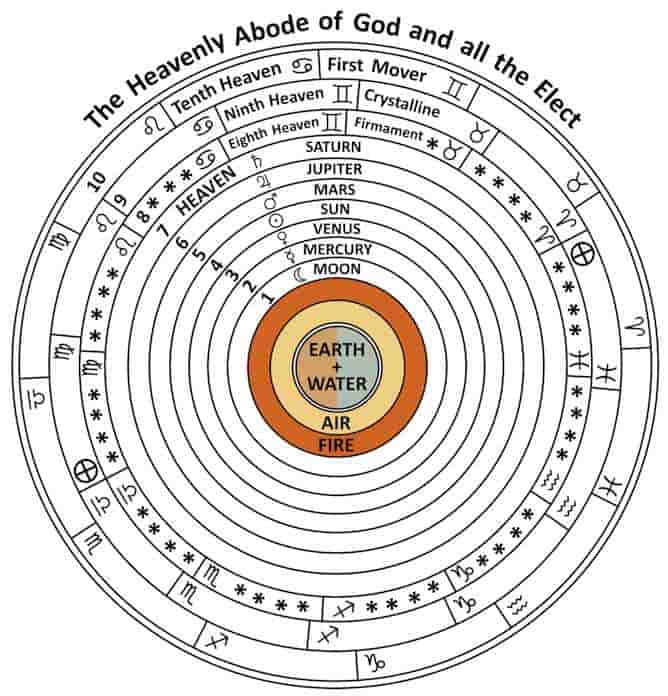
The numerical sequence (3-9) of the classical planets also corresponds directly with those in the series of planetary magic squares constructed by the Renaissance scholar and occultist Heinrich Cornelius Agrippa (1486-1535) whose highly influential Three Books Concerning Occult Philosophy were published in 1531 and 1533.

The Court Cards
In the Renaissance Tarot, the four Court Cards in each suit represent expressions of four archetypal social roles - Father, Mother, Bachelor, and Youth (Child).
It is important to note that these roles can be adopted by anyone, irrespective of gender and age. The King, Queen, Knight and Page do not, therefore, only apply to (or necessarily imply) a male or female person, or to someone who is older or younger.
In some tarot spreads, one of the court cards (called the Significator) is removed from the deck at the beginning of the reading and placed face-up on the table. The Significator card is chosen based on the inquirer's personality, current role or situation.
THE COURT CARDS
| CARD | ARCHETYPE | MEANING |
| KING | FATHER | Authority, Support |
| QUEEN | MOTHER | Provision, Nurture |
| KNIGHT | BACHELOR | Independence, Maturity |
| PAGE | YOUTH (CHILD) | Innocence, Potential |

Interpreting the Suits
The Renaissance Tarot interprets each of the suited cards by combining the meaning attributed to its value with that of the element and associations of its suit. The following examples will help to explain how this is done.
- The ACE OF WANDS combines the POWER represented by the ACE (Source) with the WILL (Purpose, Intention, Drive) represented by WANDS (Fire). It therefore indicates the principle of VOLITION and the power of the will.
- The FOUR OF CUPS combines the EXPANSION represented by the FOUR (Jupiter) with the HEART (Emotions, Sentiments, Attachments) represented by CUPS (Water). It therefore indicates the principle of GENEROSITY and the expansion of emotional concern.
- The EIGHT OF SWORDS combines the DIVERSITY represented by the EIGHT (Mercury) with the HEAD (Mind, Intellect, Rationality) represented by SWORDS (Air). It therefore indicates the principle of DEBATE and the diversity of opinions.
- The QUEEN OF COINS combines the idea of PROVISION and NURTURING represented by the QUEEN (Mother) with the BODY (Senses, Physicality, Material needs) represented by COINS (Earth). It therefore indicates the role of CUSTODIAN and the manager of property.
If a suited card is reversed, this generally indicates the opposite of its upright meaning. For example, if the FOUR OF CUPS is reversed, this indicates a contraction of emotional concern.

The Wands
The following table is a guide to the interpretation of each card in the suit of Wands, including typical indications when the card is upright and reversed.
INTERPRETING THE WANDS
| CARD | PRINCIPLE | UPRIGHT | REVERSED |
| ACE of WANDS |
VOLITION | Power of the Will |
Incapacity of the Will |
| TWO of WANDS |
INTENTION | Emergence of Motive |
Concealing of Motive |
| THREE of WANDS |
RESOLVE | Sureness of Purpose |
Uncertainty of Purpose |
| FOUR of WANDS |
VISION | Expansion of View |
Contraction of View |
| FIVE of WANDS |
DRIVE | Strength of Endeavor |
Weakness of Endeavor |
| SIX of WANDS |
ENTHUSIASM | Vitality of Zeal |
Dullness of Zeal |
| SEVEN of WANDS |
CREATION | Harmony of Design |
Disunity of Design |
| EIGHT of WANDS |
CHOICE | Diversity of Objectives |
Uniformity of Objectives |
| NINE of WANDS |
RENEWAL | Change of Direction |
Fixation of Direction |
| TEN of WANDS |
SUCCESS | Realization of Goals |
Failure of Goals |
| PAGE of WANDS |
SERVANT | Supporter of Cause |
Opponent of Cause |
| KNIGHT of WANDS |
HERO | Seeker of Glory |
Evader of Glory |
| QUEEN of WANDS |
DEFENDER | Protector of Mission |
Deserter of Mission |
| KING of WANDS |
LEADER | Source of Guidance |
Absence of Guidance |

The Cups
The following table is a guide to the interpretation of each card in the suit of Cups, including typical indications when the card is upright and reversed.
INTERPRETING THE CUPS
| CARD | PRINCIPLE | UPRIGHT | REVERSED |
| ACE of CUPS |
EMOTION | Power of the Heart |
Incapacity of the Heart |
| TWO of CUPS |
SENTIMENT | Emergence of Feelings |
Concealing of Feelings |
| THREE of CUPS |
AFFINITY | Sureness of Affection |
Uncertainty of Affection |
| FOUR of CUPS |
GENEROSITY | Expansion of Concern |
Contraction of Concern |
| FIVE of CUPS |
PASSION | Strength of Desire |
Weakness of Desire |
| SIX of CUPS |
COMPASSION | Vitality of Sympathy |
Dullness of Sympathy |
| SEVEN of CUPS |
DEVOTION | Harmony of Relations |
Disunity of Relations |
| EIGHT of CUPS |
ALLURE | Diversity of Attraction |
Uniformity of Attraction |
| NINE of CUPS |
CAPRICE | Change of Mood |
Fixation of Mood |
| TEN of CUPS |
FULFILLMENT | Realization of Hopes |
Failure of Hopes |
| PAGE of CUPS |
CHARMER | Enchanter of Hearts |
Deceiver of Hearts |
| KNIGHT of CUPS |
LOVER | Wooer of Beauty |
Rejecter of Beauty |
| QUEEN of CUPS |
CARER | Pillar of Support |
Recipient of Support |
| KING of CUPS |
BENEFACTOR | Bringer of Hope |
Tormenter of Hope |

The Swords
The following table is a guide to the interpretation of each card in the suit of Swords, including typical indications when the card is upright and reversed.
INTERPRETING THE SWORDS
| CARD | PRINCIPLE | UPRIGHT | REVERSED |
| ACE of SWORDS |
THINKING | Power of the Mind |
Incapacity of the Mind |
| TWO of SWORDS |
UNDERSTANDING | Emergence of Insight |
Concealing of Insight |
| THREE of SWORDS |
RATIONALITY | Sureness of Reason |
Uncertainty of Reason |
| FOUR of SWORDS |
KNOWLEDGE | Expansion of Learning |
Contraction of Learning |
| FIVE of SWORDS |
INGENUITY | Strength of Intellect |
Weakness of Intellect |
| SIX of SWORDS |
ORIGINALITY | Vitality of Invention |
Dullness of Invention |
| SEVEN of SWORDS |
INTEGRITY | Harmony of Ideas |
Disunity of Ideas |
| EIGHT of SWORDS |
DEBATE | Diversity of Opinion |
Uniformity of Opinion |
| NINE of SWORDS |
REVISION | Change of Detail |
Fixation of Detail |
| TEN of SWORDS |
EXPRESSION | Realization of Belief |
Failure of Belief |
| PAGE of SWORDS |
STUDENT | Seeker of Knowledge |
Suppressor of Knowledge |
| KNIGHT of SWORDS |
MAVERICK | Challenger of Norms |
Opposer of Norms |
| QUEEN of SWORDS |
ADVOCATE | Proponent of Viewpoint |
Opponent of Viewpoint |
| KING of SWORDS |
MAGISTRATE | Dispenser of Justice |
Fugitive from Justice |

The Coins
The following table is a guide to the interpretation of each card in the suit of Coins, including typical indications when the card is upright and reversed.
INTERPRETING THE COINS
| CARD | PRINCIPLE | UPRIGHT | REVERSED |
| ACE of COINS |
PERCEPTION | Power of the Senses |
Incapacity of the Senses |
| TWO of COINS |
OBSERVATION | Emergence of Information |
Concealing of Information |
| THREE of COINS |
INSPECTION | Sureness of Scrutiny |
Uncertainty of Scrutiny |
| FOUR of COINS |
PROSPERITY | Expansion of Assets |
Contraction of Assets |
| FIVE of COINS |
LABOR | Strength of Effort |
Weakness of Effort |
| SIX of COINS |
PRODUCTIVITY | Vitality of Construction |
Dullness of Construction |
| SEVEN of COINS |
COMFORT | Harmony of Being |
Disunity of Being |
| EIGHT of COINS |
SELECTION | Diversity of Preference |
Uniformity of Preference |
| NINE of COINS |
REACTION | Change of Response |
Fixation of Response |
| TEN of COINS |
PERFECTION | Realization of Excellence |
Failure of Excellence |
| PAGE of COINS |
LABORER | Provider of Services |
Receiver of Services |
| KNIGHT of COINS |
EXAMINER | Tester of Quality |
Critic of Quality |
| QUEEN of COINS |
CUSTODIAN | Manager of Property |
Neglecter of Property |
| KING of COINS |
ENTREPRENEUR | Developer of Business |
Exploiter of Business |

Leave a comment

